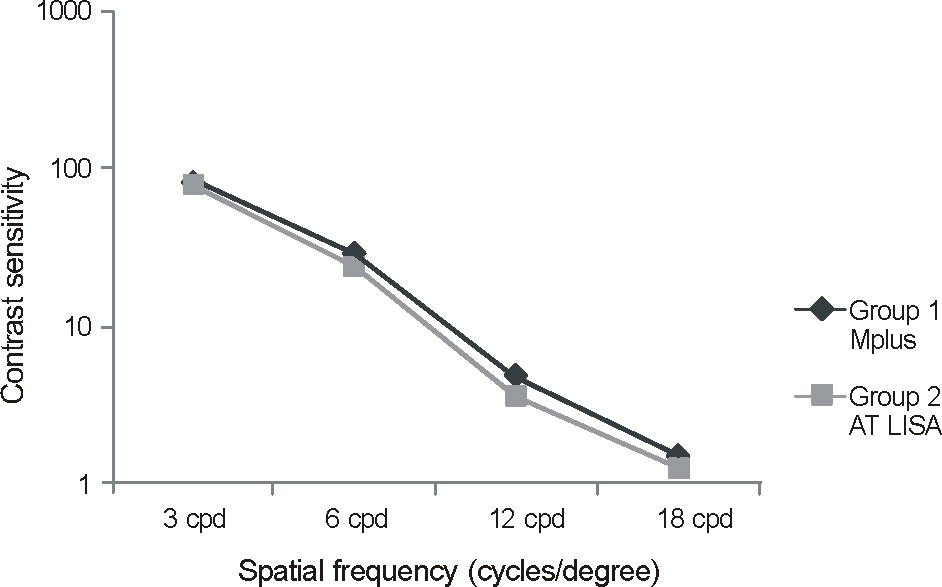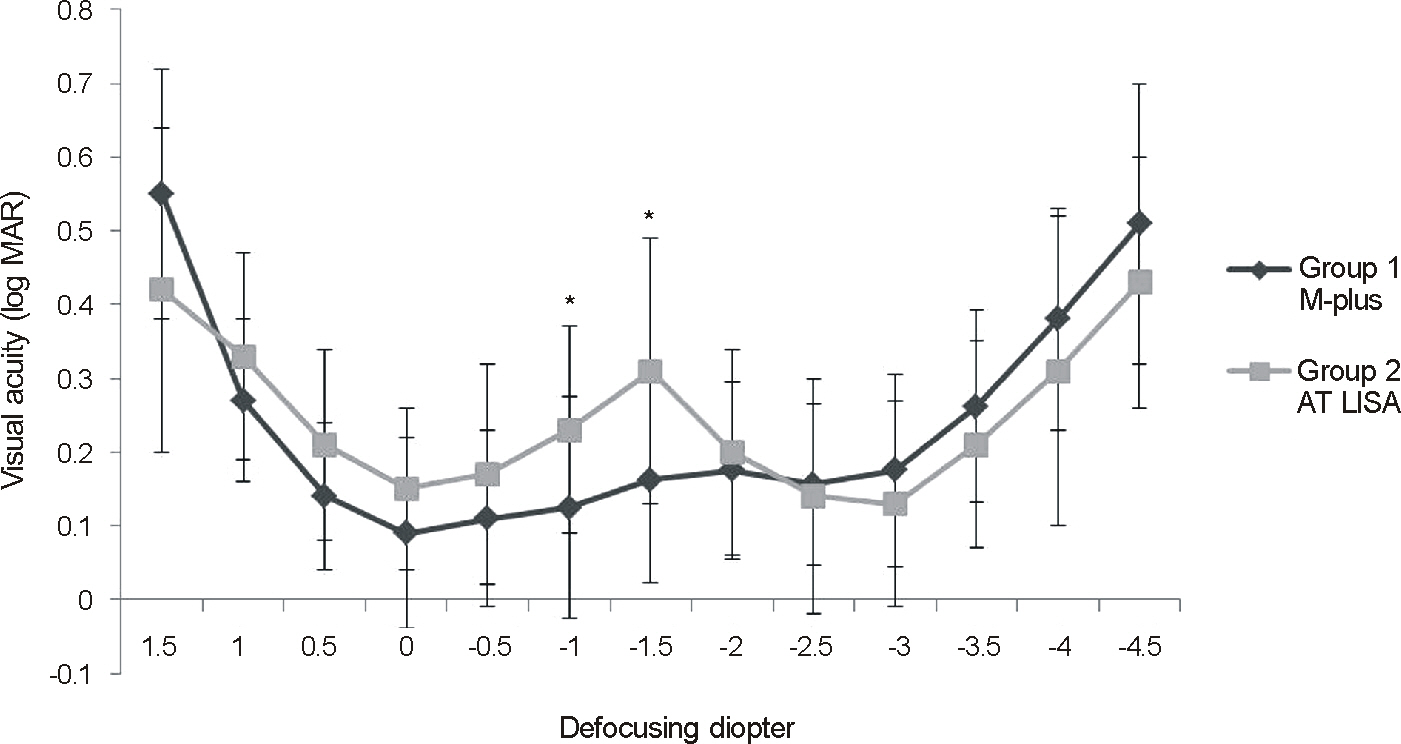J Korean Ophthalmol Soc.
2014 Apr;55(4):519-526.
Clinical Outcomes of M-Plus Intraocular Lenses
- Affiliations
-
- 1Department of Ophthalmology and Institute for Visual Science, The Catholic University of Korea College of Medicine, Seoul, Korea. ckjoo@catholic.ac.kr
- 2Department of Ophthalmology, Sanggye Paik Hospital, Inje University College of Medicine, Seoul, Korea.
Abstract
- PURPOSE
To evaluate the clinical outcomes of eyes implanted with a zonal refractive multifocal intraocular lens (IOL) with an inferior segmental near add (M-plus), and to compare the outcomes between M-plus and a diffractive-type multifocal IOL, AT LISA (366D, bifocal).
METHODS
We reviewed 19 eyes from 10 patients who were implanted with M-plus and 52 eyes of 26 patients who were implanted with AT LISA. The clinical outcomes of these 2 intraocular lenses were evaluated at 1 day and 2 months postoperatively, and consisted of distant, intermediate, and near visual acuity, contrast sensitivity, degree of tilt, and decentration using anterior segment photography, depth of focus, and patient satisfaction.
RESULTS
There were no statistical differences between the 2 groups with respect to distant vision, near vision, refractive error, contrast sensitivity, degree of tilt, decentration, or satisfaction score. The M-plus group demonstrated significantly better intermediate visual acuity. In the defocus curve, the M-plus group also demonstrated significantly better visual acuities for intermediate unfocused vision levels.
CONCLUSIONS
The M-plus multifocal IOLs are able to provide satisfactory distant and near visual acuity and visual function. The M-plus multifocal IOLs provide better intermediate vision than the AT LISA.
Keyword
MeSH Terms
Figure
Reference
-
References
1. Hofmann T, Zuberbuhler B, Cervino A, et al. Retinal straylight and complaint scores 18 months after implantation of the AcrySof monofocal and ReSTOR diffractive intraocular lenses. J Refract Surg. 2009; 25:485–92.
Article2. Hunkeler JD, Coffman TM, Paugh J, et al. Characterization of visual phenomena with the Array multifocal intraocular lens. J Cataract Refract Surg. 2002; 28:1195–204.
Article3. Leyland M, Zinicola E. Multifocal versus monofocal intraocular lenses in cataract surgery: a systematic review. Ophthalmology. 2003; 110:1789–98.4. Montés-Micó R, Alió JL. Distance and near contrast sensitivity function after multifocal intraocular lens implantation. J Cataract Refract Surg. 2003; 29:703–11.
Article5. Pieh S, Lackner B, Hanselmayer G, et al. Halo size under distance and near conditions in refractive multifocal intraocular lenses. Br J Ophthalmol. 2001; 85:816–21.
Article6. Steinert RF, Aker BL, Trentacost DJ, et al. A prospective comparative study of the AMO ARRAY zonal-progressive multifocal silicone intraocular lens and a monofocal intraocular lens. Ophthalmology. 1999; 106:1243–55.
Article7. Woodward MA, Randleman JB, Stulting RD. Dissatisfaction after multifocal intraocular lens implantation. J Cataract Refract Surg. 2009; 35:992–7.
Article8. Alfonso JF, Puchades C, Fernández-Vega L, et al. Contrast sensitivity comparison between AcrySof ReSTOR and Acri.LISA aspheric intraocular lenses. J Refract Surg. 2010; 26:471–7.
Article9. Alió JL, Elkady B, Ortiz D, Bernabeu G. Clinical outcomes and intraocular optical quality of a diffractive multifocal intraocular lens with asymmetrical light distribution. J Cataract Refract Surg. 2008; 34:942–8.
Article10. Castillo-Gómez A, Carmona-González D, Martínez-de-la-Casa JM, et al. Evaluation of image quality after implantation of 2 diffractive multifocal intraocular lens models. J Cataract Refract Surg. 2009; 35:1244–50.
Article11. Fernandez-Vega L, Madrid-Costa D, Alfonso JF, et al. Bilateral implantation of the Acri.LISA bifocal intraocular lens in myopic eyes. Eur J Ophthalmol. 2010; 20:83–9.12. Gwak JY, Choi JS, Pak KH, Baek NH. Visual and optical functions after diffractive multifocal intraocular lens. J Korean Ophthalmol Soc. 2012; 53:396–402.
Article13. Kim SM, Kim CH, Chung ES, Chung TY. Visual outcome and patient satisfaction after Implantation of Multifocal IOLs: three-month follow-up results. J Korean Ophthalmol Soc. 2012; 53:230–7.
Article14. Heo JW, Yoon HS, Shin JP, et al. A validation and reliability study of the Korean version of national eye institute visual function questionnaire 25. J Korean Ophthalmol Soc. 2010; 51:1354–67.
Article15. Alfonso JF, Fernández-Vega L, Blázquez JI, Montés-Micó R. Visual function comparison of 2 aspheric multifocal intraocular lenses. J Cataract Refract Surg. 2012; 38:242–8.
Article16. Alio JL, Plaza-Puche AB, Javaloy J, et al. Comparison of a new refractive multifocal intraocular lens with an inferior segmental near add and a diffractive multifocal intraocular lens. Ophthalmology. 2012; 119:555–63.
Article17. Alió JL, Plaza-Puche AB, Montalban R, Javaloy J. Visual outcomes with a single-optic accommodating intraocular lens and a low-addition-power rotational asymmetric multifocal intraocular lens. J Cataract Refract Surg. 2012; 38:978–85.
Article18. Montés-Micó R, López-Gil N, Pérez-Vives C, et al. In vitro optical performance of nonrotational symmetric and refractive-diffractive aspheric multifocal intraocular lenses: impact of tilt and decentration. J Cataract Refract Surg. 2012; 38:1657–63.
Article19. Patel CK, Ormonde S, Rosen PH, Bron AJ. Postoperative intraocular lens rotation: a randomized comparison of plate and loop haptic implants. Ophthalmology. 1999; 106:2190–5.20. Park CW, Lee YE, Joo CK. Changes in optical quality of cataract patients' corrected visual acuity before and after phacoemulsification. J Korean Ophthalmol Soc. 2013; 54:1208–12.
Article
- Full Text Links
- Actions
-
Cited
- CITED
-
- Close
- Share
- Similar articles
-
- Intraocular Pressure Difference With and Without Soft Contact Lenses by Noncontact Tonometry
- Removed Intraocular Lenses: A Clinical and Histopathological Study
- Clinical outcomes of currently available multifocal intraocular lenses
- Clinical Efficacy of Bunny Multifocal Intraocular Lens after Cataract Surgery
- Comparison of Nd:YAG Capsulotomy Rates between Spherical and Aspheric Intraocular Lenses





